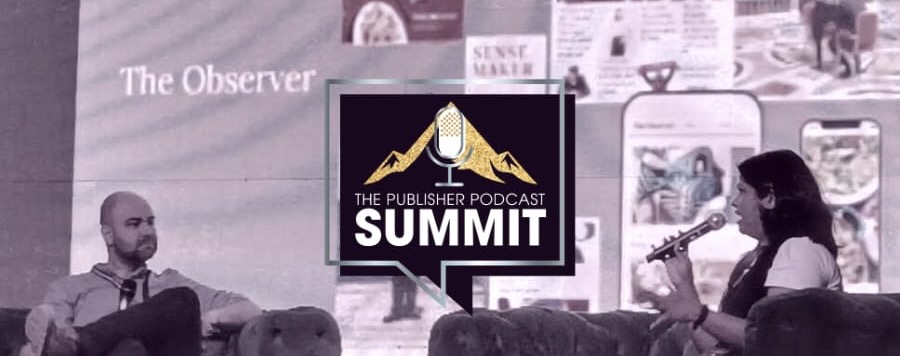Following the UK-based Tortoise Media’s purchase of the world’s oldest Sunday newspaper, The Observer, the publisher is rebranding its audio content and exploring new cultural verticals, while using its app to drive audience growth and retention. Here are some key takeaways from a talk by The Observer’s Aleena Augustine at the recent Publisher Podcast Summit, organised by MediaVoices.

Tortoise Media is nothing if not ambitious. Launched in 2018 as a mooted antidote to the fast-paced, disinformation-heavy digital publishing ecosystem of the time, its growth to date has been impressive. The strength of the brand – and the opportunity for it to grow still further – was highlighted in April this year, when Tortoise Media Ltd purchased The Observer and began reorganising around that brand. Since the takeover, all of the audio content the team produces is now branded as being from ‘The Observer’. That is true even for the award-winning ‘Tortoise Investigates’ series, which is the team’s flagship podcast series.The name recognition associated with The Observer was obviously a major draw, but the DNA of the new organisation is still recognisably that of Tortoise Media.
Speaking at MediaVoices’ Publisher Podcast Summit in London in June (which you can hear on this week’s episode of The Publisher Podcast, see Listen Now link below), The Observer’s Audience Growth Manager Aleena Augustine explained: “The way that we keep [audiences around] is by telling them that we always go by the ethos of trying to make sense of the world. We’re not breaking news. We will never be breaking news. We’re always trying to make sense of the world.”
For one thing, the content produced by the team still has that slowed-down, more analytical, easily digestible feel to it. That is especially evident when you look at the audio content and podcasts – and how it is delivered. Tortoise’s audio is, in part, delivered via its app, providing its listeners with a truly native audio experience. That, in turn, provides the team with a huge opportunity to provide context and curated recommendations that keep listeners within the app, in a way that publishing to third-party platforms do not.
Speaking at the Summit, Augustine shared the strategy behind publishing their award-winning podcasts within their app, what works when it comes to subscriber retention, and how the app can be used as an audience growth and acquisition tool as well.
Audio and acquisitions
Tortoise was among the publishers that rode the wave of increased podcast listenership in the late 2010s and early 2020s. It did so with a suite of shows that captured audio interest, providing a wide top-of-funnel that brought listeners into the ecosystem.
Augustine explained: “We reach a really wide, expanding audience. And also an audience that is highly unique to publishers in the sense that they are younger skewing, they’re female skewing, and we’re very proud of that. We can see that people, when they come to the app, it’s often new users coming [first] for the audio, and then staying for everything else.”
That acquisition is tracked by the team using its own data, gathered via the app. Augustine was blunt about the fact that – while The Observer also published to Spotify etc. – the data provided by third-party platforms is often not up to snuff when compared with owned-and-operated platforms.
To that end, the team is using that data to understand where audiences are first interacting with Observer audio content. She notes that Investigations episodes are often the first touch-point, and that the team then tracks user journeys to discover that gets people to stick around. “We really like having a platform that we own where we can get much more data from our audience, and it helps us understand it a lot more, and that is why we continue to have the app,” she explained. “We do get a lot of data both in terms of people actively reaching out, but also in terms of who’s coming in, why they’re coming in, how long they’re staying etc.”
Curation and context
There are other major benefits to having audience members listening to audio within an owned-and-operated app; that can be demonstrated by the fact that The New York Times, Zetland and De Correspondent have prioritised building apps to showcase their audio.
For The Observer, one of the most tangible benefits is being able to drop breadcrumbs leading towards other Observer content. Those recommendations – specially curated by the team – are designed to maximise retention among listeners.
Augustine explained: “We have three key ways that we do [acquisition and retention]. The first is curation. We make sure we look at stories that are really dominating the world. We curate playlists around that content so that those who are in the app get exclusive access to the content that’s curated by journalists from our newsroom, which we find is a really good retention tool, and we consistently refresh them based on what is happening around the world.”
That ability to curate is set to be accelerated with the addition of The Observer’s reputation with audiences. While Tortoise was, perhaps, best known for its ‘slow news’ content, the Observer has readers who are more interested in culture. Augustine said: “The Observer brings with it the expertise and the position in the space of food, culture and fashion… and we definitely want to reflect that across all platforms. We are trying to move into more verticals in the audio space, and really appreciate having the legacy of The Observer to give us the support in doing that as well, and also access to amazing journalists.”
Those extra verticals will necessarily expand the opportunities for the Observer team to curate content that will keep wider audience segments within the app.
Video and viability
None of which is to say that the Observer has an easy ride from hereout. The podcast ecosystem is still changing, with many advancements in voice cloning and video upending the established mores of audio publishing.
Much of The Observer’s most popular audio output is in-depth and investigative by nature. As a result, trying to add sophisticated video to accompany the audio would be effectively the same as creating a feature-length documentary. As Augustine explains, it all comes down to resource management: “We currently use video on social media as more of a discoverability tool, rather than [adding it to] the main episode. We have a bit of a challenge with our investigations – because you can’t really make a video of someone investigating. Once [the merger] settles a little bit, we are going to look at our slate and see where video [might work]. We’re not going to force video where it doesn’t make sense.”
The reality is that the podcast ecosystem is – still – evolving. However, the fundamentals of attracting and retaining audiences remain paramount. Between The Observer team’s focus on audio content to attract new listeners and a smart approach to curated recommendations to retain them, there is still plenty of headroom for The Observer to grow with an audio-first approach.
Listen to Aleena’s session at The Publisher Summits on The Publisher Podcast on your podcast app of choice.
The podcast, newsletter and events producer MediaVoices® is part of Flashes & Flames Media Ltd.



